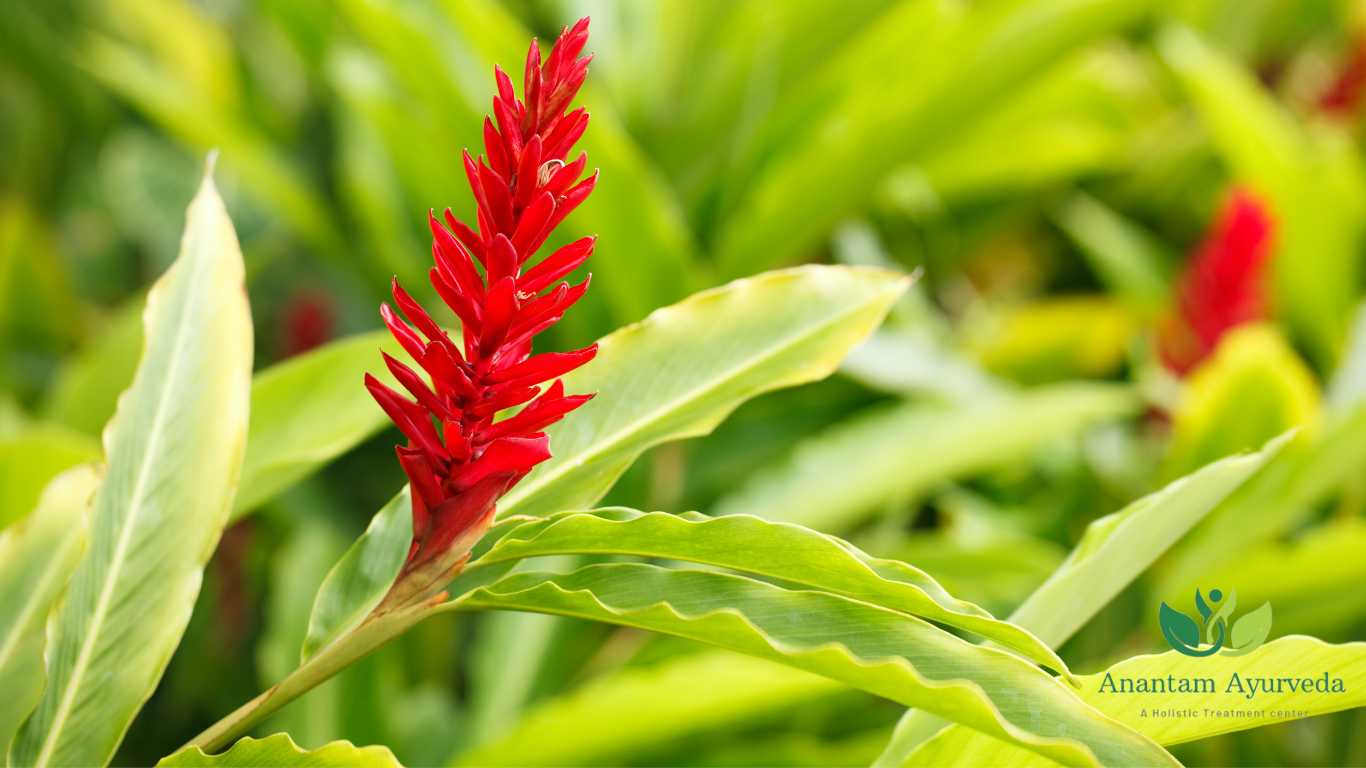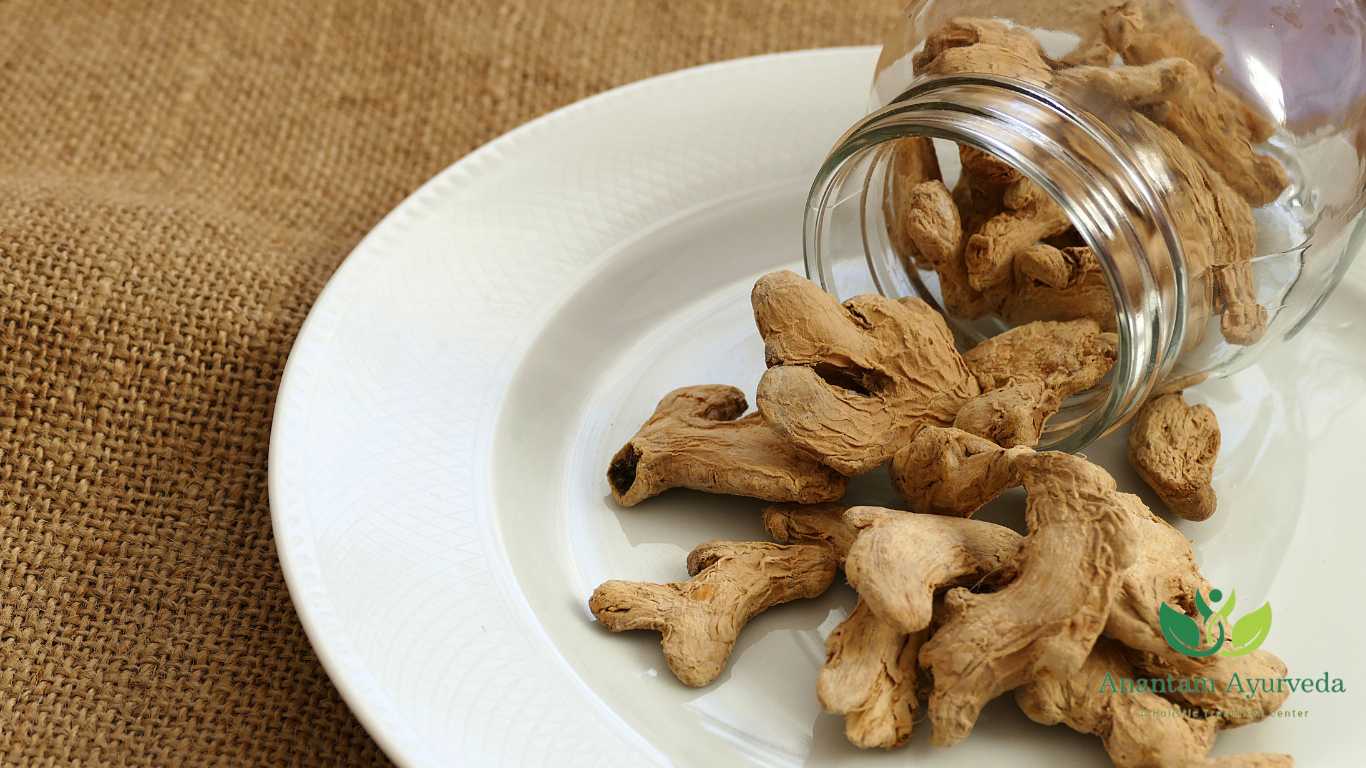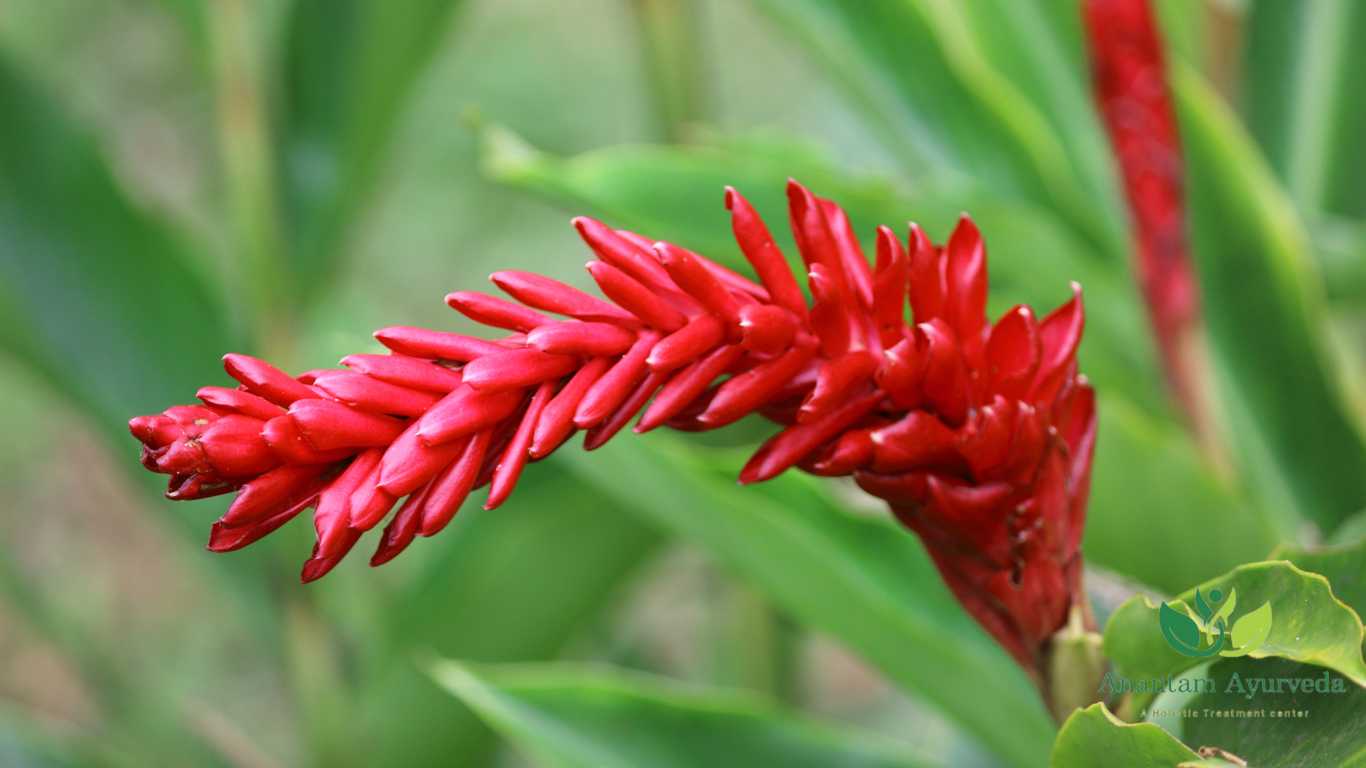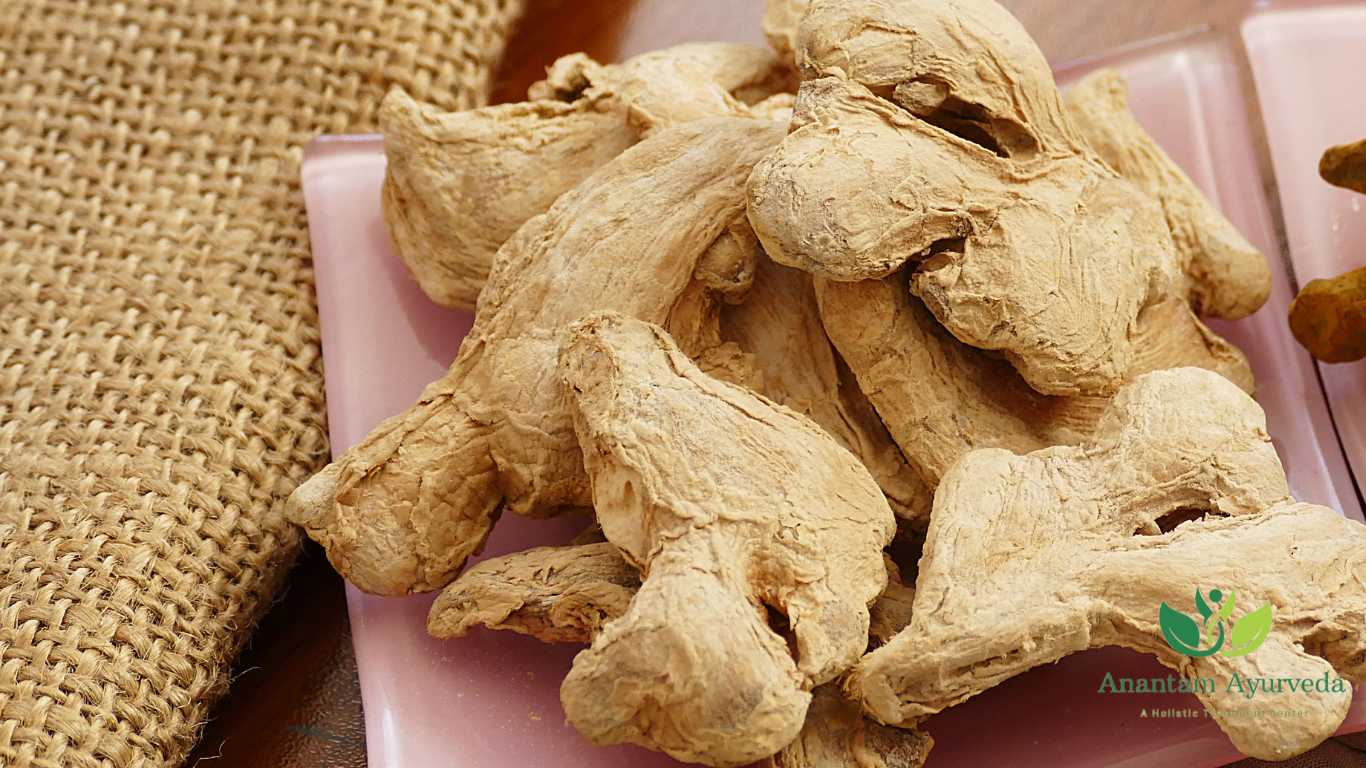Shunthi (Zingiber officinale): How to Use Shunthi Churna (Powder)
What is Shunthi?
Zingiber officinale, is a perennial herb belonging to the Zingiberaceae family. Flourishing in tropical regions, this herbaceous plant is cherished for its aromatic rhizome. The rhizome is the prized part of shunthi utilized for its exceptional culinary and medicinal qualities. Once harvested, it can be used fresh, dried, or ground into the revered shunthi churna, a powdered form that encapsulates its potent essence. Shunthi’s pungent taste and warming potency make it a dynamic addition to the world of flavors, while its bioactive compounds, including gingerol, offer a host of benefits. From supporting digestion and alleviating inflammation to boosting immunity, shunthi holds a prominent place in Ayurveda.
Chemical Composition of Shunthi
Shunthi’s remarkable properties stem from its complex chemical makeup. Key constituents that contribute to its flavor, aroma, and health-promoting effects include:
- Gingerol: The star of shunthi’s composition, gingerol is responsible for its distinctive spiciness and potent antioxidant and anti-inflammatory properties.
- Shogaol: Formed from gingerol during drying or cooking, shogaol retains some of the antioxidant qualities and contributes to the herb’s warming effect.
- Zingerone: This compound develops from gingerol when shunthi is dried or processed. Zingerone adds depth to the herb’s flavor profile and offers antioxidative benefits.
- Essential Oils: Shunthi’s volatile oils, including zingiberene and bisabolene, contribute to its aromatic essence and potential health advantages.
Useful Parts of Shunthi
Every part of the shunthi plant is valuable and serves distinct purposes:
- Rhizome: The rhizome is the most prized part of the plant. It is used fresh, dried, or ground to create shunthi churna, a powdered form revered for its various applications.
- Young Shoots: The tender young shoots are used in culinary dishes and pickles, adding a mild ginger flavor.
Qualities of Shunthi & Influence on Doshas According to Ayurveda
According to Ayurveda, shunthi possesses distinctive qualities that contribute to its exceptional healing properties:
Rasa (Taste): It is characterized by the pungent (katu) taste, which imparts a unique zest to its profile.
Guna (Quality): It exhibits the qualities of lightness (laghu) and a touch of oiliness (snigdha), enhancing its effectiveness in various applications.
Virya (Potency): With its heating potency (ushna virya), shunthi stimulates digestion, boosting metabolic processes.
Vipaka (Post-Digestive Effect): After digestion, shunthi’s post-digestive effect is sweet (madhur), contributing to its harmonizing influence on the body.
| Aspect | Qualities |
|---|---|
| Rasa (Taste) | Pungent (katu) |
| Guna (Quality) | Light (laghu), Slightly Oily (snigdha) |
| Virya (Potency) | Heating (ushna virya) |
| Vipaka (Post-Digestive Effect) | Sweet (madhur) |
In Ayurveda, the ancient Indian system of medicine, it is classified as a “hot” herb with pungent and heating qualities. It balances the Vata and Kapha doshas. This makes it a popular choice in Ayurvedic remedies aimed at improving digestion, reducing inflammation, and promoting circulation.
Health Benefits of Shunthi
Shunthi, with its array of therapeutic effects, has been celebrated in Ayurvedic texts for centuries. Let’s explore the specific health benefits:
1. Digestive Aid
Shunthi’s Impact: The pungent and warming qualities of Shunthi make it a trusted ally for digestion. According to Ayurveda, it ignites the digestive fire, known as Agni, promoting efficient digestion and nutrient absorption.
Modern Insight: Scientific studies have highlighted Shunthi’s potential to stimulate digestive enzymes, supporting gastrointestinal health and alleviating issues like bloating and indigestion.
2. Anti-Inflammatory
Shunthi’s Impact: Ayurveda attributes Shunthi with potent anti-inflammatory properties that help pacify aggravated Vata and Kapha doshas, bringing relief to inflamed tissues.
Modern Insight: Gingerol, a bioactive compound in Shunthi, is a key player in reducing inflammation and potentially offering support for conditions like osteoarthritis.
3. Nausea Relief
Shunthi’s Impact: According to Ayurveda, Shunthi can effectively curb nausea, making it a favored remedy for motion sickness, morning sickness, and digestive discomfort.
Modern Insight: Both traditional wisdom and scientific research point to Shunthi’s ability to alleviate nausea, possibly due to its influence on the nervous system and gastrointestinal tract.
4. Immune Support
Shunthi’s Impact: Ayurveda recognizes Shunthi’s potential to strengthen the immune system, protecting the body from infections and external stressors.
Modern Insight: Shunthi’s antimicrobial and antioxidant properties provide modern science with evidence of its immune-enhancing effects, potentially contributing to overall wellness.
5. Respiratory Health
Shunthi’s Impact: Ayurvedic practitioners have long used Shunthi to address respiratory discomfort, owing to its warming and decongestant qualities.
Modern Insight: Research suggests that Shunthi may help ease respiratory congestion, providing relief from conditions like coughs, colds, and even allergies.
Zingiber Officinale Medicinal Uses
Beyond its well-known culinary role, it has an extensive history as a medicinal herb. Its uses include:
- Anti-Microbial: Shunthi’s compounds exhibit antimicrobial properties, which may assist in combating bacterial and fungal infections.
- Pain Management: The herb’s analgesic properties make it a natural pain reliever for various conditions, including muscle soreness and menstrual cramps.
- Blood Sugar Regulation: Shunthi may contribute to stable blood sugar levels by enhancing insulin sensitivity.
How to Use Shunthi Churna (Powder)
Shunthi churna, a powdered form of dried ginger, is a versatile and potent Ayurvedic remedy that offers a myriad of benefits to your well-being. From enhancing digestion to soothing discomfort, incorporating it into your daily routine can be a transformative step towards optimal health.
1. Morning Ritual Elixir
Preparation: Start your day by mixing a pinch of shunthi churna with a teaspoon of honey. Add this mixture to a cup of warm water.
Benefits: This elixir kindles your digestive fire, aids in toxin elimination, and supports the immune system. The combination of shunthi and honey creates a harmonious blend that nurtures your overall well-being.
2. Digestive Tonic
Preparation: Combine shunthi churna with equal parts of cumin (jeera) and coriander (dhania) churna.
Benefits: This digestive tonic not only improves digestion but also addresses issues like bloating, indigestion, and flatulence. The synergistic blend of spices helps balance the digestive doshas and promotes optimal nutrient absorption.
3. Herbal Tea Infusion
Preparation: Add a pinch of shunthi churna to your favorite herbal tea blend.
Benefits: The infusion enhances the therapeutic properties of the tea, offering respiratory comfort and a warming sensation. It’s especially beneficial during colder months or when you’re dealing with seasonal discomfort.
4. Culinary Spice Enhancement
Preparation: Sprinkle a small amount of shunthi churna onto your cooked dishes.
Benefits: Elevate the flavor profile of your meals while benefiting from shunthi’s digestive and anti-inflammatory properties. It adds a subtle zest to your culinary creations.
5. External Application
Preparation: Mix shunthi churna with a carrier oil (such as coconut or sesame oil) to create a paste.
Benefits: Apply this paste topically to areas of discomfort or stiffness. Shunthi’s warming qualities can provide relief from muscle soreness and joint discomfort.
Safety and Precautions
While it offers a multitude of benefits, it’s essential to use it wisely:
- Dosage: Consult a healthcare professional for appropriate dosage, especially if you’re pregnant, nursing, or on medication.
- Allergic Reactions: Some individuals may be allergic. Conduct a patch test before using it topically or internally.
- Interactions: If you’re taking medications, discuss potential interactions with your healthcare provider.
You can follow us on twitter, facebook, instagram & Google News

5 Comments